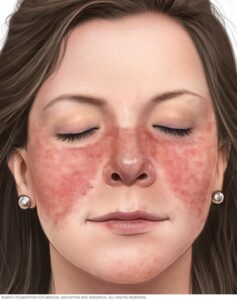immune system
Subscribe Today!
Please see below for a complete transcript of this episode.
Immune System, Part 3: Autoimmune Disorders – InViteⓇ Health Podcast, Episode 493
Hosted by Amanda Williams, MPH
*Intro music*
InVite Health Podcast Intro: Welcome to the InViteⓇ Health Podcast, where our degreed healthcare professionals are excited to offer you the most important health and wellness information you need to make informed choices about your health. You can learn more about the products discussed in each of these episodes and all that InViteⓇ Health has to offer at www.invitehealth.com/podcast. First time customers can use promo code PODCAST at checkout for an additional 15% off your first purchase. Let’s get started!
*Intro music*
Amanda Williams, MPH: [00:00:39] We’ve come to part three on our immune system podcast series, where I’m going to be discussing autoimmune conditions, what that actually means, and understanding the difference between passive and active immunity. So I’m Amanda Williams, MD, MPH, and we’ve covered a lot of ground. We’ve talked about the immune system, how its basic function is, talked about the impact of inflammation, talked about the end results of an aging immune system and immunosenescence. So today I want to talk about autoimmune and looking really at passive and active immunization. So when we think about the way that our immune system reacts when we’re exposed to a particular virus or bacteria, whatever pathogen it may be, we have a immune system response. So we have this acquired immunity, which is attained either through passive or through active immunization. So when we think about passive immunization, this is really talking about the transfer of immunity and this goes from one person to another. So when we think about maternal antibodies being passed off to the developing baby, so that would be an example of that passive immunity. So we can also get passive immunity through antibody-containing blood, such as an immune globulin. So you see certain disease conditions where immune globulins are utilized. So this is a form once again of passive immunity.† [00:02:31]
[00:02:33] Now, when we think about active immunity, this results when we have exposure to a particular disease organism that triggers the immune system to produce antibodies. So what are we now thinking about? We are thinking about antibody or adaptive or delayed immune response. So active immunity can be acquired through natural immunity or through vaccine-induced immunity. So natural immunity means we’re exposed to a particular pathogen and our body creates a means to fend this off if we are exposed to it again. Now, vaccine-induced immunity is acquired through either, you know, a killed vaccine or a weakened formed of that vaccine. There’s many different vaccines. Now we have the mRNA vaccines. So in either way, if the person comes in contact with that particular disease pathogen in the future, then the immune system recognizes this and will immediately produce the antibodies needed to fight it. So active immunity is very long-lasting in many cases, and in certain conditions, it’s actually lifelong. So when we think about someone who gets vaccinated for hepatitis B, for example, that has a long-lasting immunity. Now there’s other types of pathogens, when you think about tetanus, for example. Someone has to get re-vaccinated to that. So when it comes to understanding vaccination, this is quite complex. But at the end of the day, we know that the immune system works via active immunity and passive immunities. Passive immunity is what we get when we’re born or if we’re going under treatment for an immune globulin treatment therapy. Active immunity is going to be derived either via natural immunity or through vaccine-induced immunity.† [00:04:38]
THE DIFFERENCE BETWEEN EACH COVID-19 VACCINE & HOW TO HELP THEM WORK BETTER – INVITE HEALTH PODCAST, EPISODE 312. Listen Now>>
[00:04:40] So how can things go haywire? This is where we come in to autoimmune. So an autoimmune disease or disorder occurs when the body’s immune system attacks the body. And usually when people think about autoimmune conditions, they think of the most common ones. You think about rheumatoid arthritis, you think about lupus, Graves’ disease, Hashimoto’s, psoriasis. These are common. There’s hundreds of autoimmune conditions and some are very common. We know that in the United States alone, one out of every 15 people, one out of every 15, has an autoimmune condition. So when we think about things like ulcerative colitis, Crohn’s disease, myasthenia gravis, type one diabetes is an autoimmune condition. Understanding how this occurs is what’s important because we know that when our immune system is exposed to something, it’s going to eventually generate antibodies to this particular antigen. When the immune system cannot distinguish between what’s healthy and what is not, then it starts to destroy or attack the healthy organ or the healthy cell. And hence this is a big problem. So we see this in rheumatoid arthritis when the immune system is driving up this inflammatory response within the joint and it’s destroying that joint. So that destruction of a tissue, the abnormal growth of an organ, the change in function of an organ… We see this in Graves’ disease and Hashimoto’s thyroiditis. We know that autoimmune conditions can affect more than one system, more than one organ. We know that one autoimmune condition can drive another autoimmune condition in the body. And we’ve seen this. It’s becoming more common where you can have multiple autoimmune disorders.† [00:06:48]
[00:06:51] So how does this happen? How is it that the immune system just decides to go haywire and start attacking? Well, there’s many different schools of thought on this, but one of the most common theories out there is that it’s driven because of microorganisms. So when we think about different bacteria, viruses, drug-induced autoimmune can trigger a change in the immune system because remember, we’re dealing with this multi-functional system, remember, that’s reliant on micronutrients, macronutrients, fatty acids, the gut microbiome. So if something occurs that shifts, say you have a viral infection, and because of that viral infection, the immune system gets a little confused and it’s like, “I’m not sure what we’re supposed to be doing here. Let’s just try and destroy.” That’s a big problem.† [00:07:51]

[00:07:53] They just came out in the last month and are looking, Cedars-Sinai are finding evidence of overactive immune response, meaning the immune system goes haywire, as I describe it, when we’re talking about autoimmune in the setting of SARS-CoV-2. That’s the virus that causes COVID-19. We know that there’s all of these different autoantibodies, when people talk about natural immunity that the body generates. The problem that they’re finding is that many people who are asymptomatic or mild symptoms have these autoantibodies that are stressing the immune system to such a degree, and they are persistent much longer over time, so we’re not talking about natural protective immunity. What we are looking at is autoantibody, so that autoimmune, which is linking people to these problems with chronic inflammation, post-COVID infection that’s affecting joints, that’s affecting the nervous system. Many of these autoantibodies that they are detecting are being linked to autoimmune conditions. Remember, I said when the immune system goes haywire, one thing can spiral out of control to affect another thing. So if we can see that an infection with COVID can trigger and drive these variable responses, then we need to once again be focusing on that. How do we strengthen the immune system? How do we go about making sure that the immune system isn’t taking an exposure to an antigen and creating an autoantibody to that? So autoimmune disorders are very problematic. And to rid the system of an autoimmune condition is very hard.† [00:10:02]
[00:10:03] I mentioned a lot of these diseases, you see how far they’ve made it with many of them not far. They give people different drugs, immunosuppressant drugs to try to downregulate that immune system over-response. You have different medications that help to try to regulate thyroid function in the setting of autoimmune thyroid conditions. But at the end of the day, we have to be cognizant of the fact that our immune system goes through so much from the time that we’re born to the time that we leave this world, and when we factor in nutrient depletion, when we factor in immunosenescence, when we factor in stress and the impact that lowering levels of DHEA can play, chronic autoimmune diseases are becoming more readily acquired, we can say. Seeing more and more people who are being diagnosed with autoimmune conditions. And many of these things are tracing back to different infections. So we can’t fool ourselves and say, “OK, because I had an exposure to this, now I have natural immunity.” Because sometimes that natural immunity backfires and we actually generate autoantibodies, which are now destroying good, healthy tissues and organs and pathways.† [00:11:38]
HOW DHEA SUPPORTS HEALTHY IMMUNITY – INVITE HEALTH PODCAST, EPISODE 80. Listen Now>>
[00:11:42] So understanding how the immune system is working, understanding that passive immunity, understanding passive immunity is short term. It’s like the innate immune response, it’s short term. Passive immunity generally only lasts for a few weeks or few months. Active immunity, which correlates with our adaptive immune response, is longer lasting. So there’s a lot of moving parts, once again, when we think about our immune system and the causative reasons as to why our immune defenses can get so incredibly disrupted. When you see people who have an autoimmune disease. And they’re given these really costly, incredibly expensive and often come with a whole list of nasty side effects, these different medications that suppress their immune system, which now leaves them more vulnerable to another infection.† [00:12:53]
[00:12:56] So there’s a lot of different ways that we can help to regulate our immune system. There are many ways in which we can make small modifications to our diet, to our exercise, making sure we’re getting adequate exposure to those micro and macronutrients to enhance the body’s ability to fend off any type of a pathogen and to boost the immune function. There’s so much research out there now that shows how different nutrients, different herbal extracts can help to enhance or downregulate the way that the immune system is over-producing these different cytokines and prostaglandins. So the overactive response by the immune system can certainly get us into trouble, so we need to make sure that the immune system knows when to turn on and when to turn off. And the best way in achieving this is through healthy lifestyle. And you can do everything right. You can be eating right, exercising and still end up with an autoimmune condition. Yeah, there can be a genetic variant that’s the driving cause, can be an environmental exposure that’s unavoidable that can be weakening the immune system. But we have so much control over the action of our immune system. But you have to take the right steps. So on the next podcast, I’m going to talk about nutrients. Nutrients to support our immune system. And there are so many. We’ll look at the basic nutrients. We’ll look at some of the advanced ways in which different herbal extracts can help to enhance. We think about mushroom extract, for example, all of the different ways that we can take different supplements that can help to enhance our immune defenses.† [00:15:01]
[00:15:01] So I want to thank you so much for tuning in to the InViteⓇ Health Podcast. Remember, you can find all of our episodes for free wherever you listen to podcasts or by visiting invitehealth.com/podcast. Now, do make sure that you subscribe and you leave us a review. You can follow us on Facebook, Twitter and Instagram @invitehealth and we will see you next time for another episode of the InViteⓇ Health Podcast. [00:15:01]














